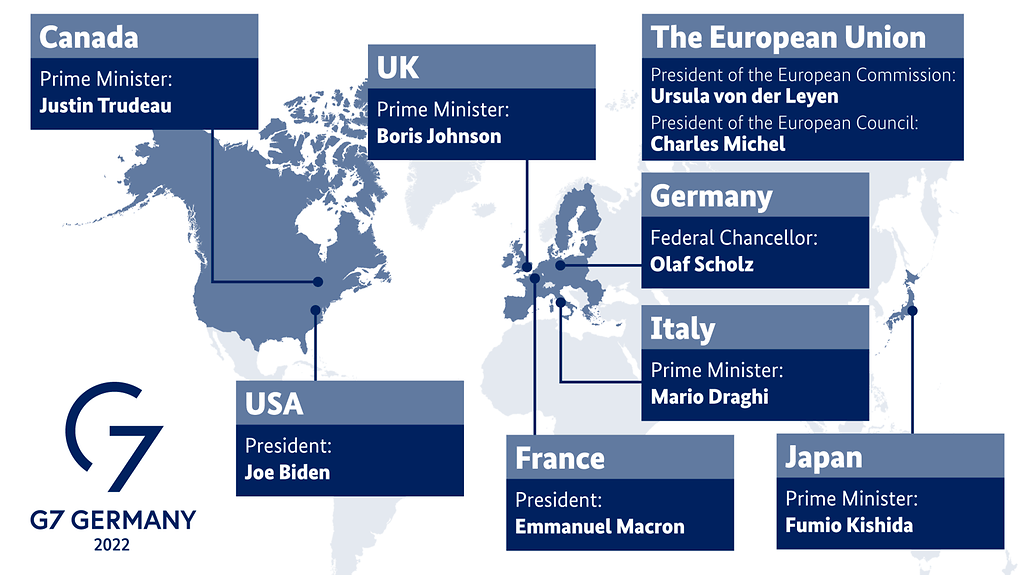HITS & MISSES AT SCHLOSS ELMAU
July 9, 2022 | Expert Insights

The G7 Summit of this year that took place in Germany was of special significance. The seven richest countries and special invitees from Asia, Africa, Latin America, and European Union contemplated a world that dramatically changed after February 24th. Global insecurities- economy, politics, health, war, and conflicts- cloud the horizon.
The participation of India- an acknowledged emerging economy- generated a great deal of interest in India and abroad. Having chosen to tread a path that differs from that being trodden by the G7 nations in Ukraine, India has been under adverse media focus in the western world for the last few months.
Background
The G7 came into existence in 1975 as a fallout of the blackmail exerted on the rich and powerful nations of the western world by the OPEC bloc. In 1998, in the bonhomie that existed after the fall of the Berlin Wall, Russia found itself being invited to sit on the high table till its annexation of Crimea triggered its expulsion. China remains an outlier in the organisation.
India is a key player in the evolving Indo-Pacific construct amidst Chinese muscle-flexing. Back in 2017, the then U.S. Secretary of State, Rex Tillerson, described the Indo-US strategic partnership as "two bookends of stability on either side of the globe”. Therefore, it is not surprising that India has been consistently attending G7 summits, albeit as an invitee. This recognition of India's place in the comity of nations as a global influencer is reflected in its participation in other influential gatherings like the I2U2 (earlier known as the West Asian Squad), G-20, BRICS, QUAD and SCO.

Analysis
Prime Minister Narendra Modi called on the developed world to invest in clean energy to secure their own future. "Access to energy should not be a privilege and advantage of the rich, but the poor should also have an equal right to energy,” he said.
His statement was in line with the tenor of the Summit, where the G7 pledged a $600 billion infrastructure initiative to assist developing countries in tackling climate change. On the issue of global food security that has been stalking the developing world as grain supplies from Ukraine and Russia dry up, Mr Modi offered Indian agricultural expertise and its massive Agri sector to help the world tide over the looming food security.
For India, too, its relationship with the west matters. India shares a large and conflicted border with China and is in the direct line of fire of Red Dragon's expansionist intentions. With the Taliban back in power in Kabul after two decades of conflict, during which India invested billions in the infrastructure of the war-ravaged nation, fears of regional instability and extremist terrorism take on a greater meaning for the region. Having evacuated Afghanistan, the western democracies must be cautioned of the danger of abandoning Afghanistan to its own devices for any length of time. This one country by itself has unmatched potential for creating mischief of the most lethal type, regionally and globally.
Altogether, the G-7 Summit presents an opportunity for both the West and India to establish and strengthen their existing partnerships while also carefully tackling the ongoing geopolitical crisis across the globe.
However, India remains under the scope, especially in Washington. This was clearly enunciated by the U.S. National Security Council coordinator Mr John Kirby when he justified India's invitation to a cynical press corps in a press brief before the Summit. He defined the G7 agenda as "deep and diverse" and one that was not trying to 'splinter off" any country from Russia. He called the Indian imports of Russian oil "sovereign decisions” but at the same time emphasised the U.S. compulsions for putting “as much international pressure on Russia as possible.” The message for India was quite clear.
Assessment
- Not limited only to the strategic sphere, India also represents the interests and concerns of other like-minded nations that have not allowed themselves to be swept along by the anti-Russian wave sweeping across most of the western world. India, it is hoped, offers an alternate view, which, even if not acceptable to both sides of the conflict in its entirety, maybe, in the long term, be the most prudent way out of the impasse.
- Encouragingly for India, the Summit reinforces the belief that India can act as a bridge between the North and the South in resolving seemingly intractable issues. This has been helped by the western impression of India’s rise in global geoeconomics. Strategically, as long as the west perceives China as a greater threat than Russia, India will always find a niche in their strategic calculus. However, India must tread a path with caution while striking a balance between western interests and its own needs.








Comments